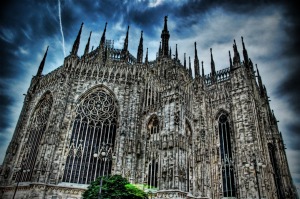 Andy Buck in his book, Leadership Matters, refers to the importance of culture and climate. Often, the first few days and weeks in September can define these characteristics for the entire school year.
Andy Buck in his book, Leadership Matters, refers to the importance of culture and climate. Often, the first few days and weeks in September can define these characteristics for the entire school year.
This blog title takes lyrics from the opening verse of Leonard Cohen’s famous song, “Hallelujah”. Hearing these words for the very first time, I absorbed them on a very human level.
So often in life we feel like we’re making things up as we go along, holding tight to a few principles on the way in the hope that everything will turn out for the best. As school leaders though, we’re required to have belief as well as hope; composing and delivering specific strategy rather than waiting for acts of serendipity.
Within our world of education, who is the “baffled king”? The cynic in me thinks of just about every Education Secretary in my lifetime, with a couple of notable exceptions!
However, other than providing myself with the opportunity to laugh at politicians, this is not a helpful view because it can lead the school leader to fall into the trap of thinking that they’re not in control of their own individual or institutional direction. If we wish to be taken seriously and respected, we have to look at ourselves as well as others. Therefore, the duty falls upon each of us to accept the prospect of becoming the Baffled King / Queen whenever change is required of us as leaders, or of our schools as organisations. On accepting this title and responsibility, the mission is, with the help of the wider team, to become assured and confident rather than remaining baffled for too long – after all, a lot of people depend on us and therein lies the main pressure of the job.

When I became head teacher at my school, I had this vision of our school becoming a fortress able to withstand any onslaught from government, Ofsted or the popular press. This approach was helpful to a point because it formed the basis of creating a strong school identity in terms of principled philosophy and practice. It underpinned the “moving of the piano” as Jarlath O’Brien would put it. It was certainly helpful in allowing us to not get caught up with the whims and fads that are always swirling as a whirlwind through the English education system. Over six years later though, with a very different school in terms of outcomes (judged Ofsted outstanding this year), but still with that strong sense of a unique history and identity, this image of a fortress seemed neither appropriate nor necessary. As such, I found myself considering as the baffled king, “With what should we replace the fortress?”
This summer I saturated myself in books exploring leadership, most of which are reviewed here. Steve Radcliffe’s book, “Leadership Plain and Simple” provided me with the inspiration. In his chapter on “Deliver”, he refers to the story of two stone carvers. On being asked individually what each of them is doing, one replies, “I’m carving stone” whilst the other one affirms, “I’m building a cathedral”. My eyes were opened. The stark contrast in the imagery of a fortress compared with a cathedral could not be greater.

The fortress by definition is a symbol of defence and resistance. The cathedral, whilst equally strong in terms of its structure and identity, is a place required to be open and prepared to welcome all people. Cathedrals also are places of outreach; they are not just places of comfort for those who are often within their walls.
Leadership requires us to be transformational. So at the beginning of this term, I welcomed back our team of staff, reminded them that our recent important successes also make us vulnerable to complacency and maintaining the status quo. I used, amongst others, the images in this blog post and we’ve begun a new mission with renewed belief and hope. Each year we hold a Vision Evening involving all staff and governors. This year we will begin to formalise our strategy for building our own cathedral!
Who knows where this will take us or what our cathedral will look like? It may not be as beautiful as Milan’s Duomo (pictured above). I am, however, sure that it will involve us welcoming others and confidently going out from our own walls to share what we have to offer as well as being open to receiving, considering and acting upon new ideas and working with new partners.
The final words of Leonard Cohen’s song are, “even though it all went wrong, I stand before the Lord of song with nothing on my tongue but Hallelujah”. Leadership doesn’t come with guarantees. Leaders can’t be certain that the route travelled will be the shortest or the easiest. But, if we have a clear, principle centred vision, allied with the desire to develop others rather than self, the destination will be heavenly in the end.
The inspiration for this post came from the video below. PS22 Chorus are a group of fifth graders from a socially and ethnically diverse New York school. Their musical director, Gregg Breinberg established the group in 2000 and I’ve been aware of them since 2009. He is a great example of how a transformational leader does not have to be the head teacher, that he / she can sustain their ability to remain transformational over a number of years within the same setting and that the ordinary can become extraordinary if the purpose is rooted in bringing out the best of all those in our care.
Watch this amazing video below
Key Questions to Consider:
- What are you “baffled” about in trying to transform your school?
- Who are the best people to help you?
- What image best describes your school at the moment?
- What image would you like your school to become?
- What needs to happen first in order to make this happen?
Good luck in building your cathedral or whatever!
With best wishes for the school year ahead.
Simon Jackson

 – identifying on occasions as “The Baffled King”!
– identifying on occasions as “The Baffled King”!

